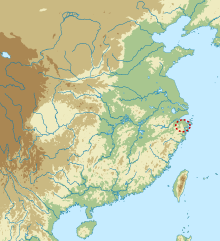
Back Cultura d'Hemudu Catalan Kultura Che-mu-tu Czech Hemudu-Kultur German Cultura Hemudu Spanish Hemudu kultuur Estonian فرهنگ همودو Persian Culture de Hemudu French Kebudayaan Hemudu ID Cultura di Hemudu Italian 河姆渡文化 Japanese
 | |||||||
| Geographical range | Eastern China | ||||||
|---|---|---|---|---|---|---|---|
| Period | Neolithic China | ||||||
| Dates | c. 5500 – c. 3300 BC | ||||||
| Chinese name | |||||||
| Chinese | 河姆渡文化 | ||||||
| |||||||


The Hemudu culture (5500 BC to 3300 BC[1]) was a Neolithic culture that flourished just south of the Hangzhou Bay in Jiangnan in modern Yuyao, Zhejiang, China. The culture may be divided into early and late phases, before and after 4000 BC respectively.[2] The site at Hemudu, 22 km northwest of Ningbo, was discovered in 1973. Hemudu sites were also discovered at Tianluoshan in Yuyao city,[3] and on the islands of Zhoushan. Hemudu are said to have differed physically from inhabitants of the Yellow River sites to the north.[4] Some authors propose that the Hemudu Culture was a source of the pre-Austronesian cultures.[5][6][7][8]
- ^ Liu & Chen (2012), p. 200.
- ^ Wang (2001), p. 209.
- ^ Zhang, Jianping; Lu, Houyuan; Sun, Guoping; Flad, Rowan; Wu, Naiqin; Huan, Xiujia; He, Keyang; Wang, Yonglei (2016). "Phytoliths reveal the earliest fine reedy textile in China at the Tianluoshan site". Scientific Reports. 6: 18664. Bibcode:2016NatSR...618664Z. doi:10.1038/srep18664. PMC 4725870. PMID 26766794.
- ^ Goodenough, Ward (1996). Prehistoric Settlement of the Pacific, Volume 86, Part 5. p. 53.
- ^ "The Bernice Pauahi Bishop Museum". Archived from the original on 2014-02-28.
- ^ Tarling, Nicholas (1999). The Cambridge History of Southeast Asia. pp. 102–103.
- ^ Liu, Li (2012). The Archaeology of China: From the Late Paleolithic to the Early Bronze Age. p. 204. ISBN 9780521643108.
- ^ Bellwood, Peter (1997). "Prehistory of the Indo-Malaysian Archipelago". Prehistory of the Indo-Malaysian Archipelago: Revised Edition. Honolulu: University of Hawaiʻi Press. pp. 205–211. ISBN 0824818830. JSTOR j.ctt24hf81.